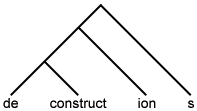Derivation and inflection
One of the key distinctions among morphemes is between derivational and inflectional morphemes. Derivational morphemes make fundamental changes to the meaning of the stem whereas inflectional morphemes are used to mark grammatical information.
Contents3. Productivity Related pages |
Derivational morphology
Derivational morphemes are affixes which are added to a lexeme to change its meaning or function. They are used to make a new, different lexeme (for example, -ly changes the adjective sad into the adverb sadly).
Most derivational morphemes change the part of speech, for example, -ance changes the verb resemble into the noun resemblance. Note that the 'e' is deleted at the end of the verb resemble when the suffix is added.
The majority of derivational morphemes that don't change the part of speech are prefixes, for example, adding un- changes the meaning of the adjective happy but it is still an adjective unhappy.
When affixes are added to a base or stem, there is usually a specific order for adding them. Inflectional suffixes are added last, and, once they are added, no more derivational affixes can be added. An example of this is given below for the word deconstructions, showing the order in which the various affixes are added:
The derivational prefix de- is added to the verb base construct to get the verb deconstruct
The derivational suffix -ion is added to the verb stem deconstruct to get the noun deconstruction
Lastly, the inflectional plural suffix -s is added to the noun to get deconstructions.

Inflectional morphology
Inflectional morphemes are affixes which carry grammatical meaning (for example, the plural -s in cats or progressive -ing in sailing). They do not change the part of speech or meaning of the word; they function to ensure that the word is in the appropriate form so the sentence is grammatically correct.
All inflectional morphemes in English are suffixes and are added after any derivational suffixes.
The most common inflectional morphemes are used in verb inflection (for example, -ed in raced, -ing in racing, -s in races) but there are suffixes for noun inflection (for example, plural -s in horses and possessive -'s in Norma's) and adjective inflection (for example, comparative -er in faster and superlative -est in fastest).
Productivity
Some kinds of affixes occur more freely than others. In relation to derivational morphology, used to create new words, we can say that some are more productive than others. For example, the suffixes -able and -ise and the prefix un- are quite productive as they can be easily used to make new words (photocopyable, accessorise, uncool) whereas the prefix per-, which we know from many Latin borrowings, such as percept and perspire, can not be used as freely (?percell even though we can say excell as well as except and expire).

